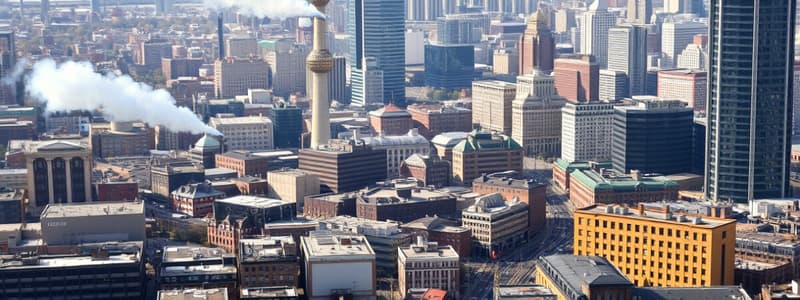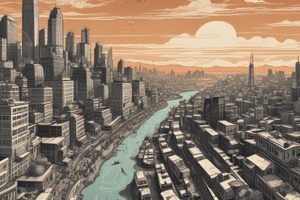Podcast
Questions and Answers
How did railroads contribute to urban growth during the Second Industrial Revolution?
How did railroads contribute to urban growth during the Second Industrial Revolution?
- By transporting raw materials and finished goods (correct)
- By providing immigrants with access to enclaves
- By transporting materials to parks and museums
- By providing the greatest number of jobs
Between 1790 and 1900, cities in America:
Between 1790 and 1900, cities in America:
- Grew slowly as they industrialized
- Shrank as rural areas became more popular
- Shrank as people began moving to the suburbs
- Grew rapidly as people moved to urban centers (correct)
At the turn of the twentieth century, the majority of the working poor lived:
At the turn of the twentieth century, the majority of the working poor lived:
- In large homes
- In rural areas
- In inner-city tenements (correct)
- In small towns
Which of the following phrases best describes American society in the early 1900s?
Which of the following phrases best describes American society in the early 1900s?
Tenement apartments at the beginning of the twentieth century were:
Tenement apartments at the beginning of the twentieth century were:
Which statement best describes urban areas during the late 1800s?
Which statement best describes urban areas during the late 1800s?
Which of the following statements best describes how wealthy people lived on a daily basis during the Gilded Age?
Which of the following statements best describes how wealthy people lived on a daily basis during the Gilded Age?
Which of the following best explains why immigrants and factory owners worked together but often lived in different parts of a city?
Which of the following best explains why immigrants and factory owners worked together but often lived in different parts of a city?
Which of the following was a direct result of increased job and educational opportunities in urban areas?
Which of the following was a direct result of increased job and educational opportunities in urban areas?
Which of the following was an effect of the growth of the service industry in the late 1800s?
Which of the following was an effect of the growth of the service industry in the late 1800s?
Flashcards are hidden until you start studying
Study Notes
Urban Growth and Industrialization
- Railroads played a crucial role in urban growth by transporting raw materials and finished goods, facilitating the movement of resources and products.
- From 1790 to 1900, American cities experienced rapid growth as people migrated to urban centers, driven by industrial job opportunities.
Living Conditions and Socioeconomic Status
- At the turn of the twentieth century, the majority of the working poor resided in inner-city tenements, which were small and dangerous living conditions.
- American society in the early 1900s was characterized by a small wealthy class, a growing middle class, and a large working poor class, highlighting economic disparities.
Urban Overcrowding and Housing
- Late 1800s urban areas were often overcrowded, with limited housing options and poor sanitation services, leading to challenging living conditions for many residents.
- Tenement apartments were notably small and considered dangerous, reflecting the struggles of urban life for low-income families.
Wealth and Lifestyle During the Gilded Age
- Wealthy individuals during the Gilded Age lived in luxurious city apartments, showcasing a stark contrast to the living conditions of the working poor in tenements.
Segregation of Living Areas
- Immigrants and factory owners often lived in different parts of cities due to public transportation that allowed factory owners to reside in more affluent areas, sometimes beyond the financial reach of immigrants.
Economic and Social Shifts
- The growth of job and educational opportunities in urban areas led to the creation of a consumer economy, indicating a shift towards increased economic activity and consumption.
- The expansion of the service industry in the late 1800s contributed to the growth of the urban middle class, reflecting broader economic changes and social mobility trends.
Studying That Suits You
Use AI to generate personalized quizzes and flashcards to suit your learning preferences.




